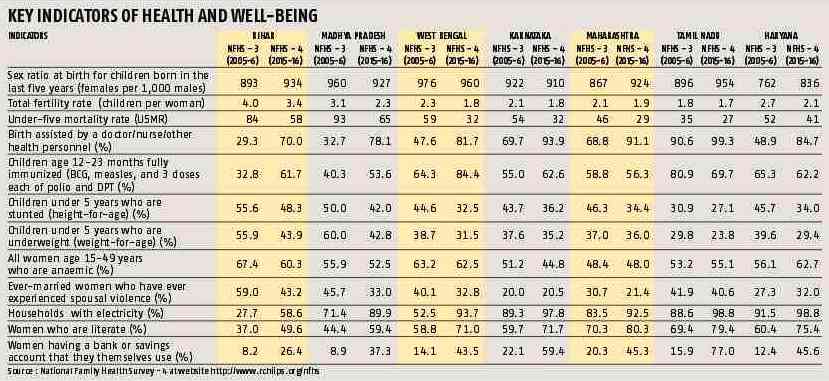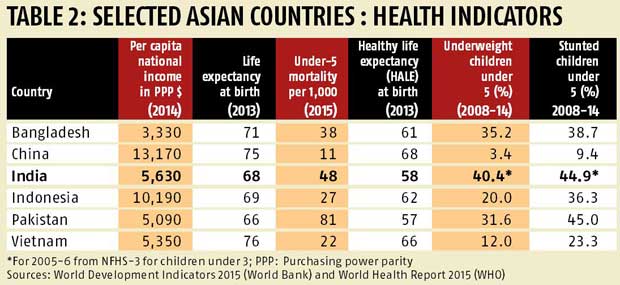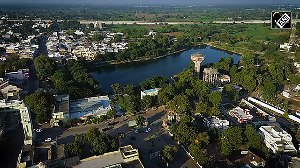
The past decade has seen significant improvements in India’s health indicators, but it still lags other Asian countries, notes Shankar Acharya
When it comes to economic news, the newspapers (especially the pink ones) are full of reports and opinion pieces on growth, inflation, markets, companies, industry, agriculture, foreign trade, capital flows, Budget deficits, banking, interest rate policy and so forth.
There is little on trends in health of the country’s population, even though that is vital not only for citizens’ basic welfare but also for the physical and mental capacities of the populace and labour force, which are fundamental determinants of the country’s long-term growth potential, as well as employment and livelihoods.
It is, therefore, unfortunate, though not surprising, that little has been written on the data emerging from the fourth round of the decadal National Family Health Survey (NFHS-4) for 2015-16 conducted by the International Institute for Population Sciences, Mumbai, on behalf of the Government of India.
Thus far, fact sheets have been uploaded on the official website for 16 states, including seven of the 10 most populous.
Each state-wise fact sheet provides fascinating data for 114 “Key Indicators”.
Information for the remaining states and the Union of India will no doubt emerge in the coming weeks and months.
But there is a lot to chew on already.
And, slightly modifying the old dictum to say, “A table is worth a thousand words”, I have included data on a dozen key indicators, comparing NFHS-4 with NFHS-3, for seven states (including six of the largest) in Table 1*.
The states chosen include two poor (Bihar and Madhya Pradesh), two middle income (West Bengal and Karnataka) and three rich (Maharashtra, Tamil Nadu and Haryana).
Per capita net state domestic product ranges from Rs 36,143 in Bihar (in 2014-15) to Rs 13,3427 in Haryana.
 What does the table tell us about trends in the past decade? First some good news:
What does the table tell us about trends in the past decade? First some good news:
- It is heartening that in the two poor states, Bihar and Madhya Pradesh, all the indicators moved in the right direction.
- Some of this improvement has been quite dramatic, as for under-five mortality, child immunisation, per cent of births assisted by health personnel, spousal violence against married women and household access to electricity in the case of Bihar, and for the first four of these as well as women’s financial inclusion in the case of Madhya Pradesh.
- Under-five mortality has declined significantly in all seven states.
- Total fertility has continued to fall in all seven states, with five of them now having rates at or below replacement rate (2.1); only Bihar remains significantly above three.
- The incidence of “stunting” (height-for-age) among children under-five and “underweight” (weight-for-age) has also dropped in all these states in the past decade, though the proportions remain high (mostly around 30-40 per cent) and, surprisingly, the proportion of underweight has declined very marginally in Maharashtra.
- The proportion of births assisted by health personnel has increased in all states.
- The per cent of literacy amongst women has increased significantly in all states, though the test of literacy is quite a minimal one;
- There has been a major increase across all states in respect of women’s access to bank accounts, perhaps partly attributable to the Jan Dhan drive by the current government.
- Household access to electricity has increased in all seven states, and is now at 90 per cent or higher in all except Bihar.
 Not everything is hunky dory. Thus:
Not everything is hunky dory. Thus:
- In three of the seven states the sex ratio at birth has fallen a little, admittedly from fairly high levels. These are the states of Karnataka, Madhya Pradesh and West Bengal.
- The proportion of young children fully immunised has, somewhat surprisingly, declined in the rich states of Maharashtra and Haryana, whereas in the other five states there have been welcome increases.
- The proportion of women aged 15-49, who are anaemic, has remained surprisingly high and unchanged in Maharashtra, Tamil Nadu and West Bengal, while it has actually increased significantly in Haryana.
- Otherwise well-performing Tamil Nadu also shows a high and almost unchanged proportion (around 40 percent) of married women who have experienced spousal violence. In Haryana, the proportion has increased over the decade from 27 percent to 32 percent. Contrast with the major declines in Bihar, Madhya Pradesh and Maharashtra.
- On balance, the decade has recorded substantial improvements in health and well-being in these states. That said, it is important to look at the level of some of India’s key indicators in comparison with other countries, especially other populous developing nations in Asia. Table 2 provides this perspective:
- India’s life expectancy at birth is significantly lower than that of China, Vietnam and Bangladesh, a little higher than Pakistan’s and about the same as Indonesia’s. China obviously has much higher purchasing power parity (PPP) adjusted per capita national income than India, as does Indonesia. Vietnam and Pakistan have comparable income levels and Bangladesh’s PPP per capita income is only two-thirds of India’s.
- The World Health Organization (WHO) constructs an indicator “Healthy Life Expectancy at birth (HALE). According to this measure, for 2013, India’s HALE was lower than all comparator countries, except Pakistan.
- Similarly, India’s under-five mortality level is markedly higher than in all these countries except Pakistan; four times higher than China’s and over double Vietnam’s.
- The story on the proportion of underweight and stunted children under-5 follows the same pattern: highest in India with the exception of Pakistan.
In short, although the past decade has seen significant improvements in India’s indicators of health and well-being, the nation still lags behind other comparator Asian countries (except Pakistan) by substantial margins.
The challenge ahead for central and state governments remains enormous.
Shankar Acharya is honorary professor at ICRIER and former Chief Economic Adviser to the Government of India. Views are personal.











